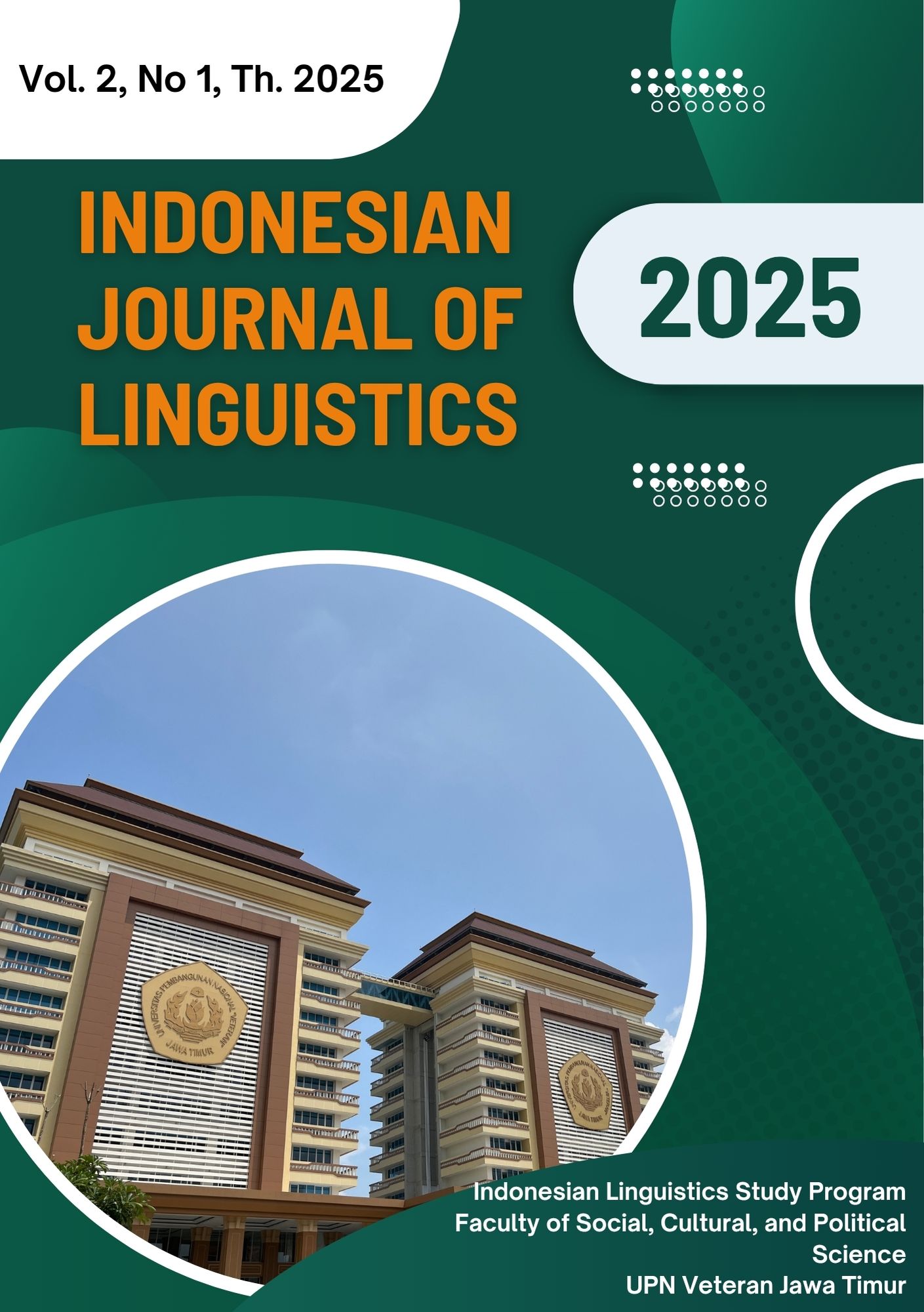MISOGINI DALAM KOMENTAR DI AKUN INSTAGRAM @CLARAANDJAVI: KAJIAN SEMANTIK
DOI:
https://doi.org/10.33005/ijl.v2i1.26Keywords:
Misogyny, Semantics, InstagramAbstract
Misogyny is one of the forms of hate speech against women that often appears on social media, including in comments on Instagram accounts. This research aims to identify the forms of misogyny in the comments of @claraandjavi's Instagram account and analyze its conceptual meaning. The method used in this research is descriptive qualitative method with data sources in the form of comments containing elements of misogyny and data collection techniques in the form of observation and documentary evidence of comments in the form of screenshots. The results showed that there
were comments containing misogyny utterances, such as several comments “dia cowo ya?”, “rata tembok”, and “nanti biar di modif sendirif”. This shows that the comments posted have conceptual meanings that relate to women's value of their physical appearance and reflect the prevailing social construction of gender related to unrealistic beauty standards and the comments also contribute to reinforcing the objectification of women's bodies, women are often judged based on their body or physical appearance. That physical appearance is everything for women and women must have a
certain body shape to be considered attractive, without regard to ability or personality.aspects of ability or personality.
References
Abednego, F. A., Kuswoyo, C., Cen Lu, & Wijaya, G. E. (2021). Analisis Pemilihan Social Media Influencer Instagram pada Generasi Y dan Generasi Z di Bandung. JRB-Jurnal Riset Bisnis, 5(1), 57–73. https://doi.org/10.35814/jrb.v5i1.2558
Amsyah, R., Kurniawan, E., & Fasya, M. (2023). Makna Ujaran Azmi Farahdiba Lestaluhu Sebagai Fakta Ujaran Kebencian. Sastra, & Budaya |, 1(1), 2023.
C, & Khaerunnisa. (2022). UJARAN KEBENCIAN SEMANTIK. Jurnal KANSASI (Jurnal Pendidikan Bahasa Dan Sastra Indonesia), 1(1), 57–68. http://jurnal.stkippersada.ac.id/jurnal/index.php/KAN
Chaer, A. (2009). Pengantar Semantik Bahasa Indonesia (Revisi). PTRINEKACIPTA.
Febrianti, N., Abdulkarim, A., Malihah, E., & Fitriasari, S. (2020). Analisis Muatan Kajian Gender pada Buku Teks Pendidikan Kewarganegaraan di Perguruan Tinggi. Jurnal Inspirasi Pendidikan, 10(1), 70–77. https://doi.org/10.21067/jip.v10i1.4328
Ginting, H., & Ginting, A. (2019). Beberapa Teori Dan Pendekatan Semantik. Pendidikan Bahasa Indonesia Dan Sastra (Pendistra), 71–78. https://doi.org/10.54367/pendistra.v2i2.594
Koto, A., & Munandar, M. (2024). Budaya Misogini dan Anti Perempuan dalam Literatur Hadis. Al Qalam: Jurnal Ilmiah Keagamaan Dan Kemasyarakatan, 18(4), 2422. https://doi.org/10.35931/aq.v18i4.3548
Manne, K. (2018). Down girl: The logic of misogyny. Oxford University Press.
Mellinia, W., & Sary, K. A. (2022). Representasi feminisme dalam film Kim Jiyoung, Born 1982. In LITERASI: Jurnal Ilmu Komunikasi, 1(1).
Natanael, D. B. (2022). MISOGINI DAN KONFRONTASI ANTARSESAMA TOKOH PEREMPUAN DALAM NOVEL DIVERGENT. Braz Dent J., 33(1), 1–12.
Natanael, D. B. (2024). Muatan Misoginistik dalam Karya Seni Lukis Edgar Degas sebagai Perspektif Historis untuk Menyoroti Permasalahan Objektifikasi Perempuan dalam Media Sosial dan Periklanan. 4(1), 1–12.
Pitrianti, S., & Maryani, S. (2023). Analisis Bahasa Slang Di Media Sosial Instagram. Jurnal Ilmiah SEMANTIKA, 5(01), 9–16. https://doi.org/10.46772/semantika.v5i01.1305
RAFAEL, A. M. D., & Pradhana, N. I. (2024). Defamasi Iriana Widodo Melalui Misogini Dan Defemisme Perempuan (Kajian Linguistik Forensik). HINEF: Jurnal Rumpun Ilmu Pendidikan, 3(1), 103–118. https://doi.org/10.37792/hinef.v3i1.1192
Respati, E. A. R. I. (2023). MISOGINI DALAM KONTEN GENDERTROLLING. 43(1), 97–102.
Saimon, A., & Tazudin, N. A. H. (2022). Leksis Gender Dalam Novel a. Samad Said: Satu Analisis Medan Semantik. RENTAS: Jurnal Bahasa, Sastera Dan Budaya, 1(1), 51–84. https://doi.org/10.32890/rentas2022.1.2
SAUSSURE, F. DE. (1959). COURSE IN GENERAL LINGUISTICS (C. BALLY & A. SECHEHAYE, Eds.). THE PHILOSOPHICAL LIBRARY, INC.
Subandi, S. (2011). Deskripsi Kualitatif Sebagai Satu Metode Dalam Penelitian Pertunjukan. Harmonia Journal of Arts Research and Education, 11(2). https://doi.org/10.15294/harmonia.v11i2.2210
Downloads
Published
How to Cite
Issue
Section
License
Copyright (c) 2025 Indonesian Journal of Linguistics

This work is licensed under a Creative Commons Attribution-ShareAlike 4.0 International License.
Indonesian Journal of Linguistics by Universitas Pembangunan Nasional “Veteran” Jawa Timur is licensed under a Creative Commons Attribution-ShareAlike 4.0 International License.
1. The journal allows the author to hold the copyright of the article without restrictions.
2. The journal allows the author(s) to retain publishing rights without restrictions
3. The legal formal aspect of journal publication accessibility refers to Creative Commons Attribution Share-Alike (CC BY-SA).
4. The Creative Commons Attribution Share-Alike (CC BY-SA) license allows re-distribution and re-use of a licensed work on the conditions that the creator is appropriately credited and that any derivative work is made available under “the same, similar or a compatible license”. Other than the conditions mentioned above, the editorial board is not responsible for copyright violation.








